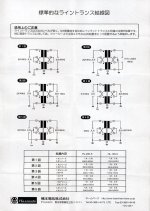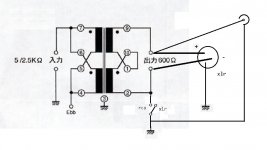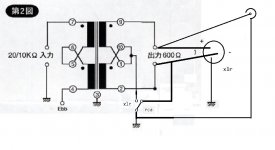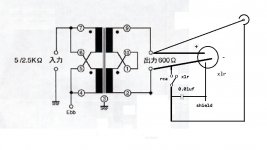What is wrong with grounding the center tap? As shown in diag 2.
Normally single ended voltage levels are assumed to be half the balanced.
Normally single ended voltage levels are assumed to be half the balanced.
Last edited:
The first diagram is what I generally do, grounding the center tap eliminates galvanic isolation, results in some imbalance between the balanced outputs and ground and when using the RCA jack reduces gain by half and substantially increases leakage inductance. (It will also affect HF frequency response.)
Edit: I suspect the grounded secondary shown in all diagrams is related to their liability, it's not commonly done in end uses. (Look at the designs of old transformer coupled recording consoles for guidance)
I've built a lot of line stages with balanced outputs over the years and a very few that provided both RCA and XLR options and used the first circuit.
DC leakage between the primary and secondary in transformers I have measured has always been well under 1uA, however in the event of a direct short the full supply voltage may appear on the secondary which could be quite hazardous. There should be no exposed contacts that could become energized in the event of a failure. (RCA jack shell should always be grounded whether or not in use as shown in first diagram)
In the event of a transformer insulation failure the second diagram of course is safer, that's the only advantage I've identified. (There are other ways to provide some protection against insulation failure)
Edit: I suspect the grounded secondary shown in all diagrams is related to their liability, it's not commonly done in end uses. (Look at the designs of old transformer coupled recording consoles for guidance)
I've built a lot of line stages with balanced outputs over the years and a very few that provided both RCA and XLR options and used the first circuit.
DC leakage between the primary and secondary in transformers I have measured has always been well under 1uA, however in the event of a direct short the full supply voltage may appear on the secondary which could be quite hazardous. There should be no exposed contacts that could become energized in the event of a failure. (RCA jack shell should always be grounded whether or not in use as shown in first diagram)
In the event of a transformer insulation failure the second diagram of course is safer, that's the only advantage I've identified. (There are other ways to provide some protection against insulation failure)
Yes, that will work and will still be safe in the event of a transformer insulation failure.
It will not provide galvanic isolation between the line stage and power amplifier - which may not be a big deal if the amplifier uses an input transformer, balanced operation will still provide reasonable resistance to ground loop induced noise.
It will not provide galvanic isolation between the line stage and power amplifier - which may not be a big deal if the amplifier uses an input transformer, balanced operation will still provide reasonable resistance to ground loop induced noise.
The first diagram is what I generally do, grounding the center tap eliminates galvanic isolation, results in some imbalance between the balanced outputs and ground and when using the RCA jack reduces gain by half and substantially increases leakage inductance. (It will also affect HF frequency response.)
Hi Kevin. I don't ground the center tap to upstream ground but only to XLR ground and transformer shield. Then again i don't use single ended connections at all but from distant memories there may have been hum when the output ground was galvanically isolated.
Is gain at RCA outputs not supposed to be half? Have some recollection of power amps with a 6db gain switch to equalise SE/BAL gains.
If one is ok with a reduced gain at RCA, keeping the same grounding arrangement: center tap to output ground has the advantage of dispensing with the switch.
Last edited:
Mine are all completely floating/balanced which prompted the comments about dc leakage currents.
I follow pro-audio conventions for the most part. Shield is grounded at source end and I use a 0.01uF cap at the receiving end. I usually use Neutrik bulkhead connectors bolted right to chassis.
There is an argument for reducing output levels 6dB for RCA, but depending on the amplifier design that may result in degraded SNR. (My amps tend to have the same sensitivity whether the RCA or balanced input option is chosen since I use 1:1 input transformers, so I don't reduce the output relative to balanced outs.)
My current signal chain has BSS Varicurves for room EQ (sacrilege lol) with balanced I/0 on both channels, floating balanced transformer output from the line stage, and balanced transformer input in the power amps.
No hum problems at all. Speakers are extremely efficient >100dB and -3dB at 28Hz.
I follow pro-audio conventions for the most part. Shield is grounded at source end and I use a 0.01uF cap at the receiving end. I usually use Neutrik bulkhead connectors bolted right to chassis.
There is an argument for reducing output levels 6dB for RCA, but depending on the amplifier design that may result in degraded SNR. (My amps tend to have the same sensitivity whether the RCA or balanced input option is chosen since I use 1:1 input transformers, so I don't reduce the output relative to balanced outs.)
My current signal chain has BSS Varicurves for room EQ (sacrilege lol) with balanced I/0 on both channels, floating balanced transformer output from the line stage, and balanced transformer input in the power amps.
No hum problems at all. Speakers are extremely efficient >100dB and -3dB at 28Hz.
Balanced interconnects so not have a ground in the audio circuit. XLR pin #1 is a shield, it is connected to the chassis at the connector, not the audio circuit common (aka ground).
- Status
- Not open for further replies.
- Home
- Design & Build
- Parts
- transformer output "rca or xlr"




